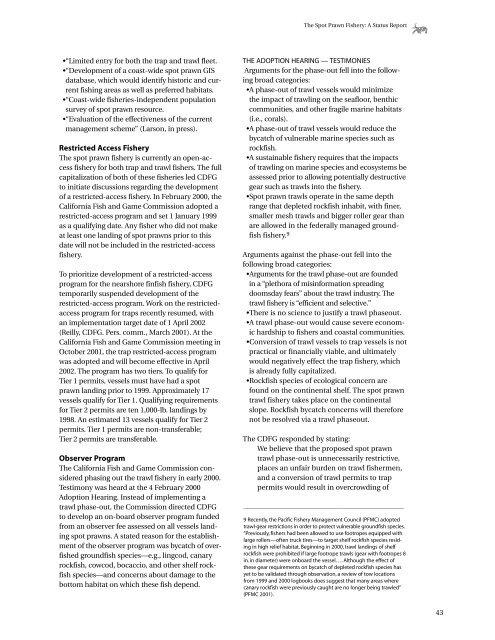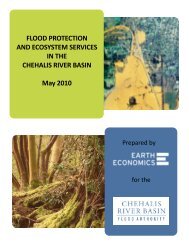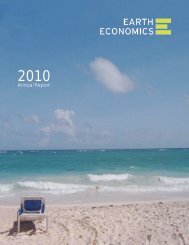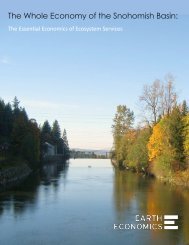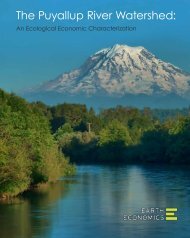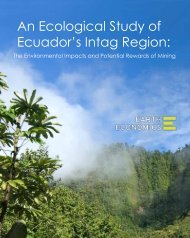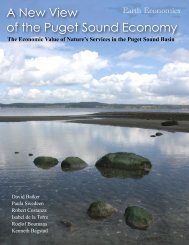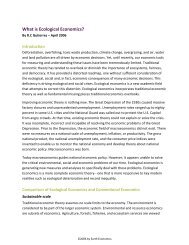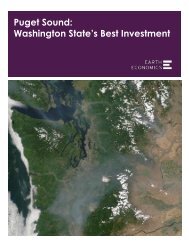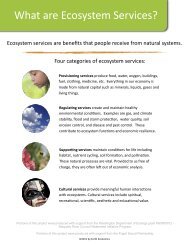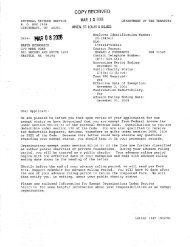The Spot Prawn Fishery: A Status Report - Earth Economics
The Spot Prawn Fishery: A Status Report - Earth Economics
The Spot Prawn Fishery: A Status Report - Earth Economics
Create successful ePaper yourself
Turn your PDF publications into a flip-book with our unique Google optimized e-Paper software.
<strong>The</strong> <strong>Spot</strong> <strong>Prawn</strong> <strong>Fishery</strong>: A <strong>Status</strong> <strong>Report</strong><br />
•“Limited entry for both the trap and trawl fleet.<br />
•“Development of a coast-wide spot prawn GIS<br />
database, which would identify historic and current<br />
fishing areas as well as preferred habitats.<br />
•“Coast-wide fisheries-independent population<br />
survey of spot prawn resource.<br />
•“Evaluation of the effectiveness of the current<br />
management scheme” (Larson, in press).<br />
Restricted Access <strong>Fishery</strong><br />
<strong>The</strong> spot prawn fishery is currently an open-access<br />
fishery for both trap and trawl fishers. <strong>The</strong> full<br />
capitalization of both of these fisheries led CDFG<br />
to initiate discussions regarding the development<br />
of a restricted-access fishery. In February 2000, the<br />
California Fish and Game Commission adopted a<br />
restricted-access program and set 1 January 1999<br />
as a qualifying date. Any fisher who did not make<br />
at least one landing of spot prawns prior to this<br />
date will not be included in the restricted-access<br />
fishery.<br />
To prioritize development of a restricted-access<br />
program for the nearshore finfish fishery, CDFG<br />
temporarily suspended development of the<br />
restricted-access program. Work on the restrictedaccess<br />
program for traps recently resumed, with<br />
an implementation target date of 1 April 2002<br />
(Reilly, CDFG. Pers. comm., March 2001). At the<br />
California Fish and Game Commission meeting in<br />
October 2001, the trap restricted-access program<br />
was adopted and will become effective in April<br />
2002. <strong>The</strong> program has two tiers. To qualify for<br />
Tier 1 permits, vessels must have had a spot<br />
prawn landing prior to 1999. Approximately 17<br />
vessels qualify for Tier 1. Qualifying requirements<br />
for Tier 2 permits are ten 1,000-lb. landings by<br />
1998. An estimated 13 vessels qualify for Tier 2<br />
permits. Tier 1 permits are non-transferable;<br />
Tier 2 permits are transferable.<br />
Observer Program<br />
<strong>The</strong> California Fish and Game Commission considered<br />
phasing out the trawl fishery in early 2000.<br />
Testimony was heard at the 4 February 2000<br />
Adoption Hearing. Instead of implementing a<br />
trawl phase-out, the Commission directed CDFG<br />
to develop an on-board observer program funded<br />
from an observer fee assessed on all vessels landing<br />
spot prawns. A stated reason for the establishment<br />
of the observer program was bycatch of overfished<br />
groundfish species—e.g., lingcod, canary<br />
rockfish, cowcod, bocaccio, and other shelf rockfish<br />
species—and concerns about damage to the<br />
bottom habitat on which these fish depend.<br />
THE ADOPTION HEARING — TESTIMONIES<br />
Arguments for the phase-out fell into the following<br />
broad categories:<br />
•A phase-out of trawl vessels would minimize<br />
the impact of trawling on the seafloor, benthic<br />
communities, and other fragile marine habitats<br />
(i.e., corals).<br />
•A phase-out of trawl vessels would reduce the<br />
bycatch of vulnerable marine species such as<br />
rockfish.<br />
•A sustainable fishery requires that the impacts<br />
of trawling on marine species and ecosystems be<br />
assessed prior to allowing potentially destructive<br />
gear such as trawls into the fishery.<br />
•<strong>Spot</strong> prawn trawls operate in the same depth<br />
range that depleted rockfish inhabit, with finer,<br />
smaller mesh trawls and bigger roller gear than<br />
are allowed in the federally managed groundfish<br />
fishery. 9<br />
Arguments against the phase-out fell into the<br />
following broad categories:<br />
•Arguments for the trawl phase-out are founded<br />
in a “plethora of misinformation spreading<br />
doomsday fears” about the trawl industry. <strong>The</strong><br />
trawl fishery is “efficient and selective.”<br />
•<strong>The</strong>re is no science to justify a trawl phaseout.<br />
•A trawl phase-out would cause severe economic<br />
hardship to fishers and coastal communities.<br />
•Conversion of trawl vessels to trap vessels is not<br />
practical or financially viable, and ultimately<br />
would negatively effect the trap fishery, which<br />
is already fully capitalized.<br />
•Rockfish species of ecological concern are<br />
found on the continental shelf. <strong>The</strong> spot prawn<br />
trawl fishery takes place on the continental<br />
slope. Rockfish bycatch concerns will therefore<br />
not be resolved via a trawl phaseout.<br />
<strong>The</strong> CDFG responded by stating:<br />
We believe that the proposed spot prawn<br />
trawl phase-out is unnecessarily restrictive,<br />
places an unfair burden on trawl fishermen,<br />
and a conversion of trawl permits to trap<br />
permits would result in overcrowding of<br />
__________________________________________________________<br />
9 Recently, the Pacific <strong>Fishery</strong> Management Council (PFMC) adopted<br />
trawl-gear restrictions in order to protect vulnerable groundfish species.<br />
“Previously, fishers had been allowed to use footropes equipped with<br />
large rollers—often truck tires—to target shelf rockfish species residing<br />
in high relief habitat. Beginning in 2000, trawl landings of shelf<br />
rockfish were prohibited if large footrope trawls (gear with footropes 8<br />
in. in diameter) were onboard the vessel. ...Although the effect of<br />
these gear requirements on bycatch of depleted rockfish species has<br />
yet to be validated through observation, a review of tow locations<br />
from 1999 and 2000 logbooks does suggest that many areas where<br />
canary rockfish were previously caught are no longer being trawled”<br />
(PFMC 2001).<br />
43


